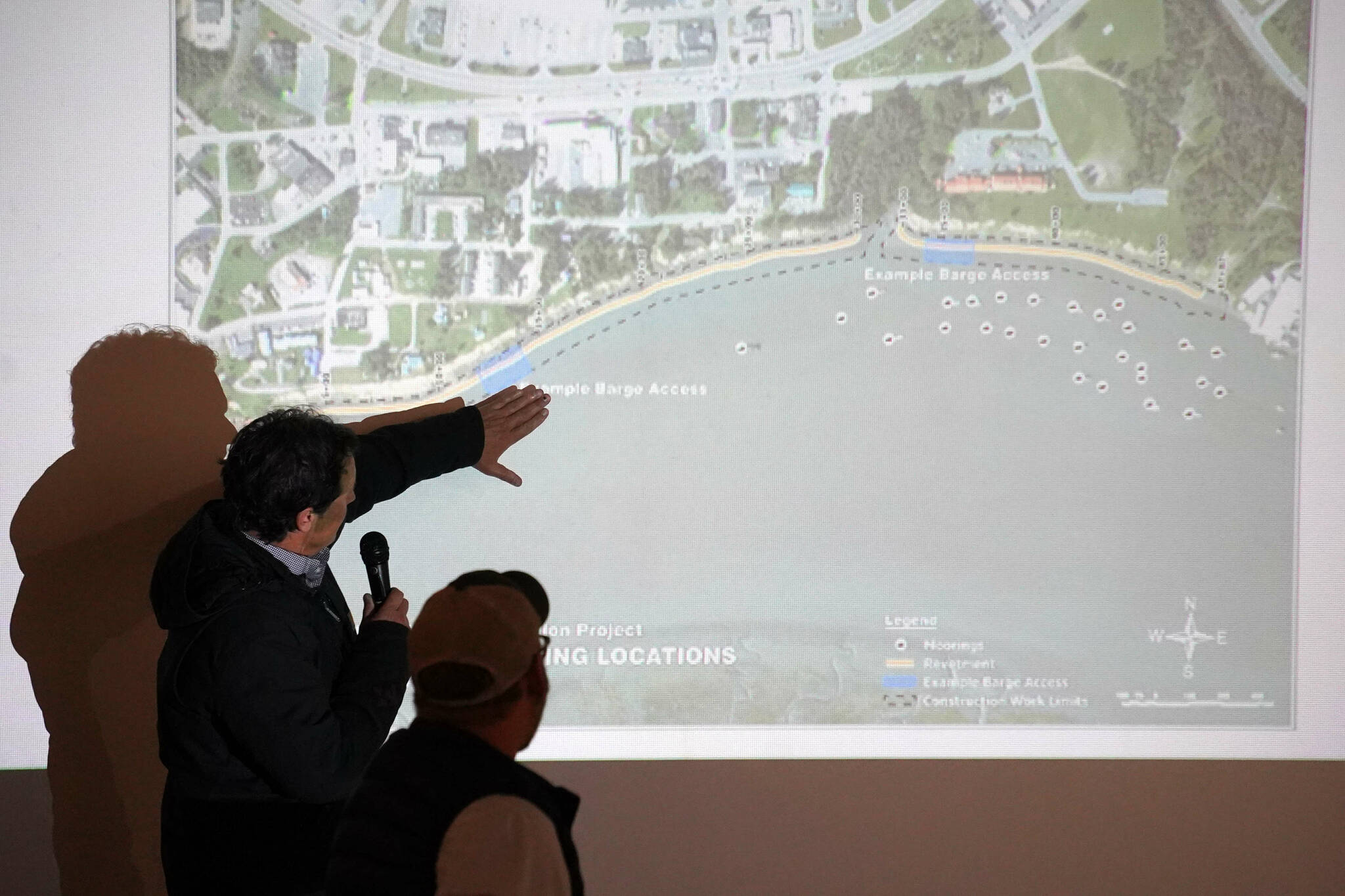Local construction of the Kenai River Bluff Stabilization Project will begin around May 16, with the project set to be completed in October. That’s what project leads said during an update meeting at the Kenai Chamber of Commerce on Wednesday.
Project leads from the U.S. Army Corps of Engineers Alaska District, Western Marine Construction, HDR and the City of Kenai fielded questions from around 50 attendees during the meeting. Western Marine is tasked with constructing the roughly 5,000-feet-long berm from the mouth of the Kenai River to near the city dock, at the bluff’s toe, to catch falling sediment.
Leif Hammes, part of the corps’ chief civil works project management section, said the project will be heavily underway in Kenai by the end of May, operating constantly until completion. Much work has already been done, he said, as Western Marine has been producing rock in Sand Point since the project’s ribbon cutting in June — “we just don’t see the results yet.”
That’ll change soon, when barges begin ferrying the rock from Sand Point — in the Aleutians — to the Kenai River. There will be two barges constantly cycling, one offloading rock for construction as the other is bringing back another load.
The project will take precautions to avoid certain wildlife — like a required 150-meter berth from any seen beluga whales and a policy of “maximum” avoidance of harbor seals. Those precautions are why the May 16 start date was chosen, because that’s when the endangered Cook Inlet beluga whales are thought to be out of the Kenai River.
When constructing the revetment, excavators will dig 4-feet deep on the bank of the river, during low tide, and the wall will be anchored into that space and stretch around 22 feet above the water. The wall will be the same height across its full length, but the thickness of the wall will differ to meet the depths and conditions experienced along its path.
Many commercial fishers came to the meeting to ask about how the construction would impact their operations — both driftnetters actively fishing in Cook Inlet and vessels traveling back and forth on the Kenai River to deliver their hauls.
Jerrod Stafford, one of the project managers from Western Marine, said that his crews would be working as close to the bluff as possible, with the barges anchored in place and much of the actual work of construction happening on shore. He expects to complete “somewhere between 30 and 50 feet per day.” Vessels traveling up and down the river, he said, should be able to pass by while construction is underway.
Hours will vary to chase the tides, but Stafford said work should generally occur within a 6 a.m. to 8 p.m. window, seven days a week.
There will be more activity in the river than usual this year, and likely some inconveniences in the short term, he said, but the project will provide benefit over the long term.
The wall is expected to hold up for a long time. KC Kent, a coastal engineer from HDR, who did design for the revetment, said the rock sourced from Sand Point underwent around a dozen tests, “really stringent bars” that it has to meet. Hammes said one of those tests included freezing and thawing 90 times to simulate 90 years of winter.
Once installed, she said, erosion will continue until the bluff meets an angle of repose defined by the revetment, when revegetation will be able to occur and strengthen the bluff face.
Hammes said that the corps built a similar revetment in Nome that faces similar conditions from cold, wind and waves in the 1950s. It’s showing age, but it’s still there.
“This is one of those things your children should be benefiting from.”
That said, Hammes said that the City of Kenai will need to perform some maintenance likely starting in 25 years — though he said the corps will provide a maintenance plan, status reports and other guidance to help ensure the revetment lasts.
More information about the project can be found at kenai.city.
Reach reporter Jake Dye at jacob.dye@peninsulaclarion.com.

